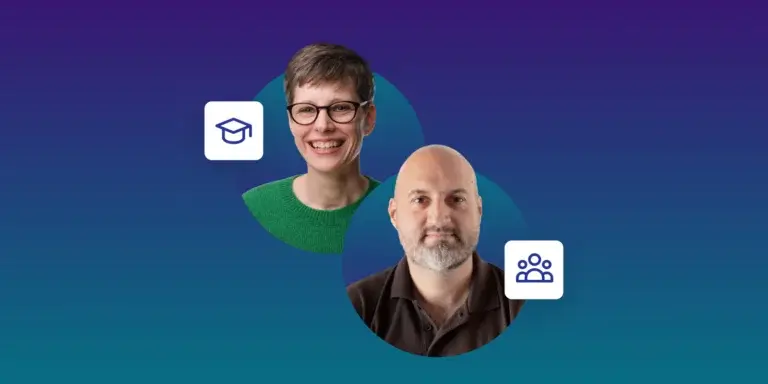Table of Contents
After years of focusing on marketing efforts to bring in new leads, companies finally realized there was more value in retention. That’s how customer education became an obsession to increase product adoption and satisfaction.
But if you started customer education with traditional training methods (either in-person or fully online), you wouldn’t be able to reach everyone, let alone meet the needs of today’s learners.
That’s where blended learning comes in.
Let me dive into what makes blended learning training programs a must-have for scaling and customer training.
What is blended learning in SaaS customer education?
Blended learning is a training approach that combines traditional classroom settings and in-person instruction with digital, online learning activities.
This hybrid model combines the best of both worlds, giving learners the flexibility of self-paced online modules alongside the interactivity and personal attention that instructor-led sessions bring, like live onboarding. This combination enables hybrid learning for onboarding that meets the diverse needs of your learners and improves blended customer success training.
But any hybrid or blended learning model has been evolving, too, as the concept isn’t new.
Traditionally, it was just combined on-site with online learning.
Today, it reunites different delivery methods, technologies, and interactive tools to offer personalized, flexible, and engaging learning. It also integrates adaptive learning, microlearning, immersive technologies, mobile access, collaboration, and data-driven insights to create a dynamic and effective learning environment.
Why blended learning matters for SaaS companies
Blended learning matters for SaaS companies because it drives learning outcomes that directly map to customer success metrics like adoption, retention, and time to value.
Real-time onboarding sessions with self-directed training modules can help you get new users active faster, get value, and use your product sooner. That’s time to value and general product adoption. Sounds good, right?
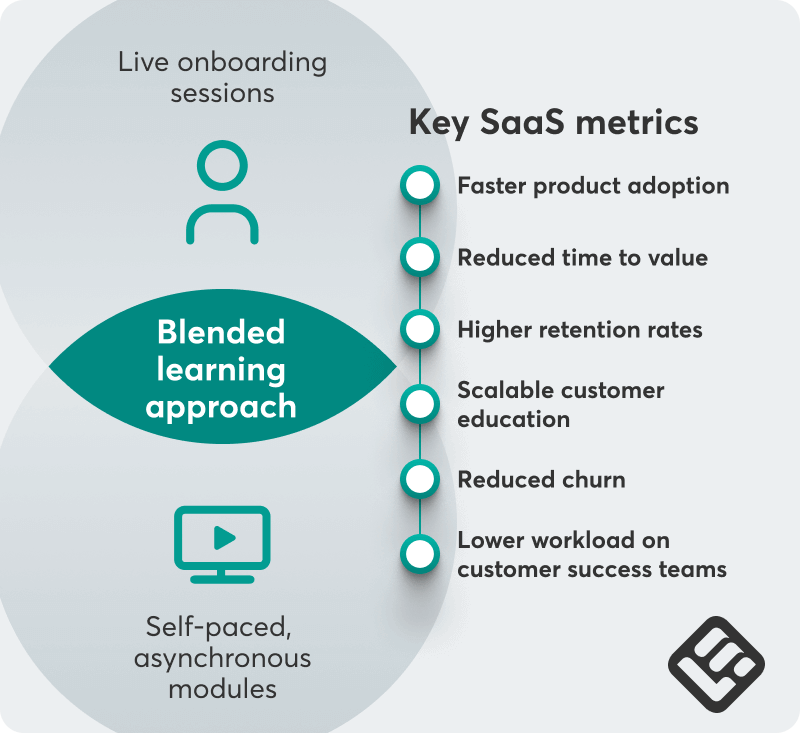
Blended learning’s flexible training environment helps smaller businesses scale customer education. This keeps users engaged with multiple formats and personalized learning paths.
Retention then improves as users continue to participate as a result of gaining more confidence and using more features of your product.
💡Did you know?
Research shows that organizations that take a blended approach to learning have up to 51% higher retention rates and customer satisfaction, leading to revenue growth and decreased churn.
Want more? Blended learning also lightens the load on customer success teams. This happens as you shift repeatable training into async modules and keep live interactions for high-touch, personalized support and online resources.
Key benefits of blended learning for SaaS
This in-between in-person and online training has its own set of advantages for customer education.
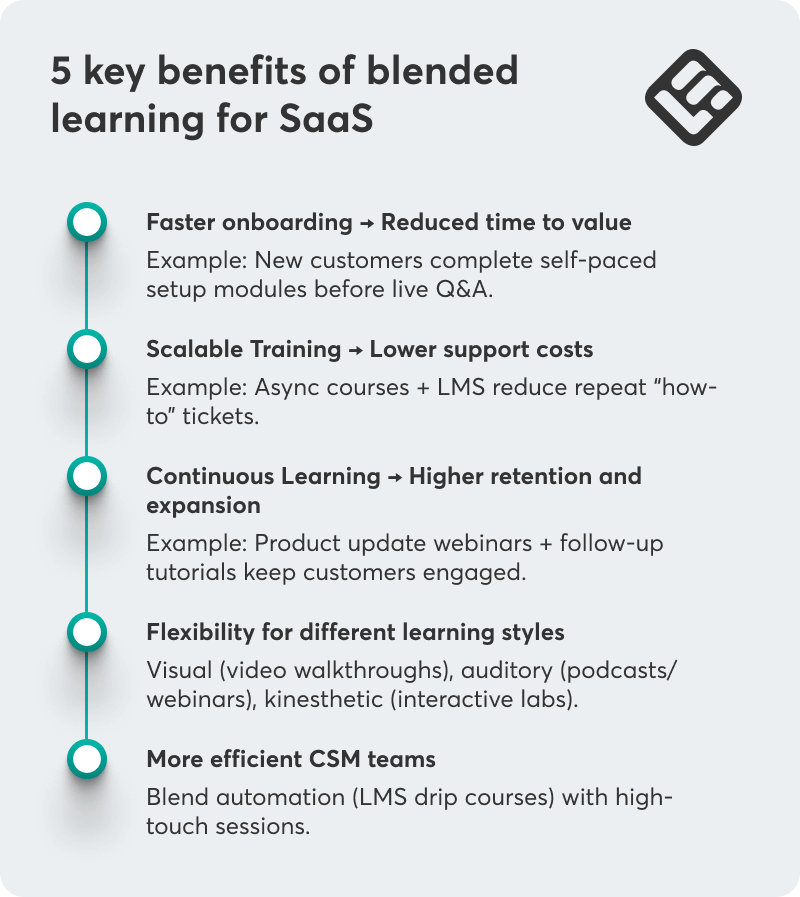
Faster onboarding → Reduced time to value
Getting started with blended learning that allows new users to complete critical self-paced setup modules before attending any live onboarding sessions is one way to do this. This primes customers through live sessions so they can start to understand your product.
Example: New SaaS users can watch onboarding videos and follow tutorials at their own pace, then attend live Q&A sessions to remove roadblocks and get to ROI faster.
Scalable training → Lower support costs
Providing async representations of content with LMS management reduces the number of “how-to” support tickets. Customers are always looking for answers within self-help content, reducing the work of the support team on more complex cases and lessening the cost of service.
Example: An LMS is a home for product walkthroughs and troubleshooting guides that are always available, getting rid of common support requests.
Continuous learning → Higher retention and expansion
You always need a blended learning model because traditional training methods tend to be boring. A major advantage of blended learning is that it can present information that keeps customers engaged.
In fact, blended learning is what you make of it. Mix formats, create dedicated content for unique learning preferences, ditch text for videos, scenarios, and quizzes, and try social learning or add in live webinars.
Example: In your next product online learning experiences include short videos explaining key features, quizzes to test understanding and product walkthroughs to simulate workflows.
Flexibility for different learning styles → Personalized learning experiences
Another big benefit of blended learning is how flexible it is. Customers get to choose how they want to get up to speed with your product through custom-blended learning content that fits their individual needs.
Self-paced learning, for instance, is possible because blended learning exists. This format changes the way customers learn by letting them revisit modules, videos, group activities or tutorials as many times as they need.
Example: A SaaS provider can offer new customers access to an online knowledge base with step-by-step tutorials and interactive videos so they can master the basics before diving into advanced custom training.
Here’s another real-life example from Zenius‘ Co-Founder, Rohit Agarwal:
“The best way to keep your customers engaged is by personalizing their journey, which is exactly what blended learning does. For example, a few years ago, I worked with a SaaS provider client to enhance their customer training and retention. We opted for a 2-week blended learning model, with a live introductory and FAQ module and online in-depth modules in the middle explaining features, shortcuts, and troubleshooting the software. It allowed us to assign specific training material for different teams based on their specific use cases of the product. This approach helped customers to focus on features they were most likely to use, reducing learning downtime.”
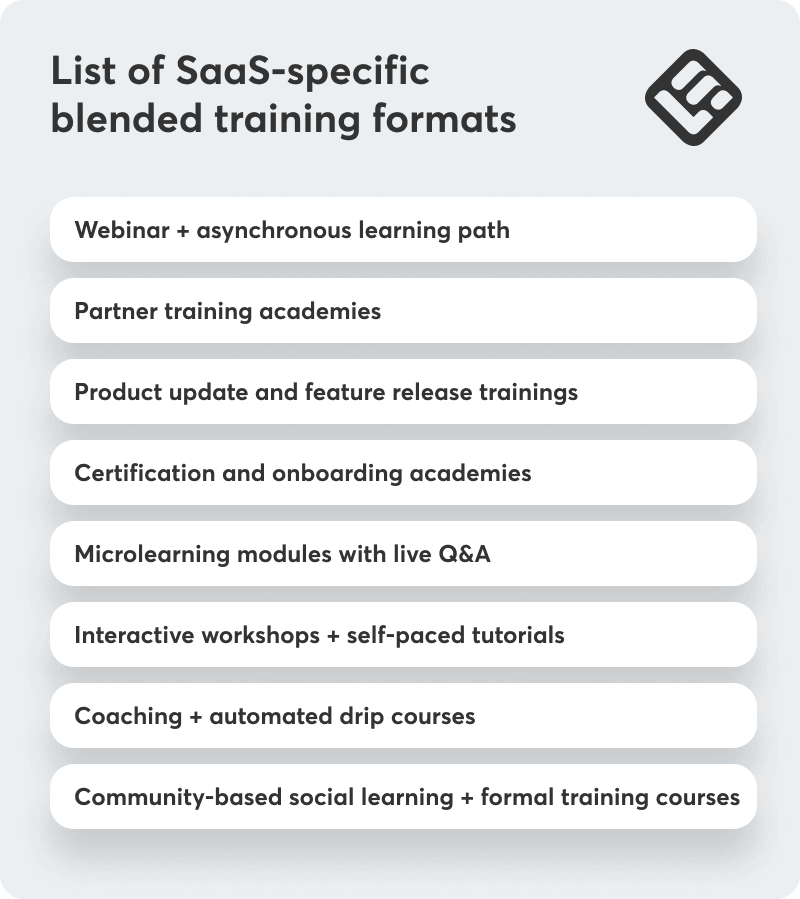
More efficient CSM teams → Higher-quality customer interactions
When combining drip courses via email with live sessions, blended learning allows the customer success teams to focus on the face-to-face learning that matters most. This combination minimizes the need for manual training but preserves the human touch required for complex questions.
Example: You could use an LMS to automatically drip-feed basic courses while saving live coaching calls, face-to-face instruction and Q&A webinars for problem-solving and customer-specific advice.
SaaS use cases of blended learning programs
To see how this works, let’s look at some use cases in action with real companies using blended learning methods.
Example 1: Scaling onboarding for a PLG SaaS
Lokalise is a localization platform and company that created an online academy to teach localization education to pros and entrepreneurs.
They used LearnWorlds to combine self-paced micro learning courses, certification programs, collaborative learning and student engagement to provide learners with flexibility without lack of depth.
This approach enabled Lokalise to raise its profile, gain the attention of a wide variety of learners (including decision makers) and become a leader in the market for localization education.
Example 2: Partner training programs
Blip teamed up with LearnWorlds to create Blip Academy and provide blended learning to businesses, employees, customers and partners. They combined live sessions with automated self-paced courses to reduce onboarding for their AI-driven conversation platform.
By doing so Blip reduced onboarding time by 41%, support tickets by 15% and increased course completion rates by 10x.
Example 3: Customer academies for enterprise accounts.
To replace weekly onboarding webinars with on-demand courses Workable built a professional branded learning experience for their customers with LearnWorlds.
In less than a year since launch the Workable Academy has had over 2,000 active learners and 19 courses including a wide range of digital learning resources and updates. This has reduced support to active ratios and increased customer product adoption.
Best practices for SaaS teams using blended learning
A successful blended learning approach for SaaS teams starts when you target learning objectives that align with customer success metrics like product adoption, retention and a decrease in support tickets.
Measuring engagement and completion numbers (like the ones above) is a must to optimize the impact of training and ensure that educational efforts match your broader business goals.
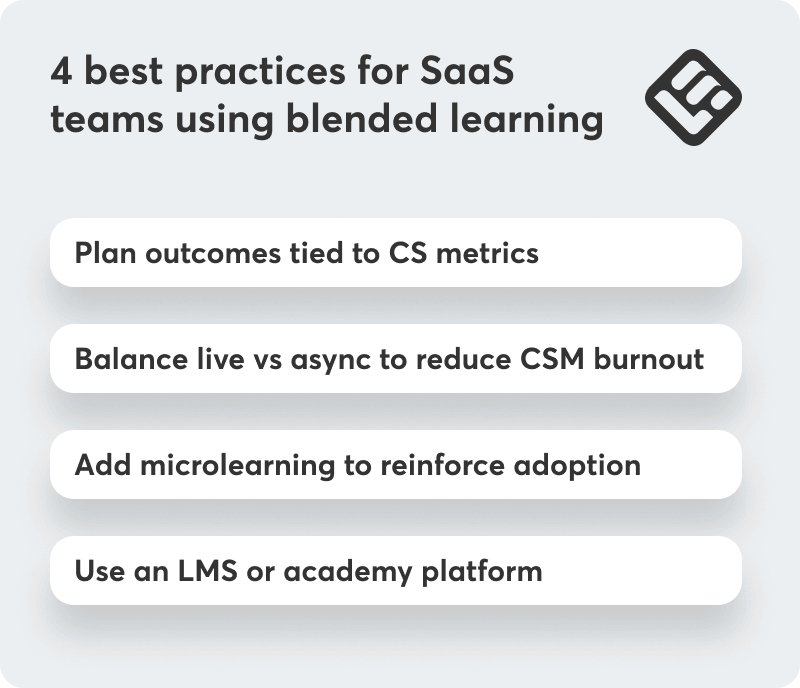
Balancing the scale of live instructor-led classes with on-demand content is the key to reducing burnout for Customer Success Managers. You can decrease the number of live interactions or let customers train on their own time so CSMs can learn to manage their workload more sustainably.
LearnWorlds makes this easy with its flexible course delivery options such as being able to organize and connect live group training with heavy self-paced modules. The latter are perfect for taking the load off you for repetitive training without putting a strain on CSMs.
To reinforce adoption add microlearning into the mix. Bite-sized lessons in multimedia formats like videos, quizzes and interactive content are all built for the busy lives SaaS customers have. LearnWorlds enriches microlearning with tools like dynamic ebooks, self-assessments and interactive video elements.
Challenges and solutions for SaaS adoption
Below you’ll find the main challenges SaaS teams face and how you can address them with your blended learning programs.
Challenge 1: Over-reliance on CSMs
CSMs are forced to do training that’s repetitive and can burn out when their time isn’t used effectively.
Convert basic training to self-paced asynchronous content that their customers can access anywhere, freeing up CSMs to offer direct support and growth.
Challenge 2: Complex or confusing onboarding
New users find it hard to get started with a new product. This can be the main source of frustration and the reason they leave in the first place.
Deliver customized onboarding journeys, show clear progress and offer hands-on training so your users can act and win fast so they’ll feel comfortable using your product in the future.
Challenge 3: Lack of ongoing engagement post-signup
Any user can start onboarding. But if they don’t get the habit trigger going, users might lack motivation to keep using your product unless they’re reminded all the time.
Add behavioral triggers to bring up chat messages in the moment (like when using a specific feature or struggling to find functionality).
Ready to launch your customer education program?
You can use the approach above to launch or scale your customer education programs.
By using LearnWorlds, you can automate your customer education efforts and offer accessible content delivery and personalized learning paths to your learners.
With features like interactive videos, course insights, and SCORM-compliant support, LearnWorlds is an ideal LMS for companies seeking to enhance their customer and corporate training and scale them effectively.
Try LearnWorlds for free and help your customers use your product to its full potential.

Alexandra Cote
Alexandra Cote is a SaaS growth marketer and online instructor who's worked with dozens of brands in the MarTech, HR tech, and productivity space. She's also a strong supporter of staying happy at work and choosing a healthy career path.
FAQ
Everything you have ever wondered, but were too afraid to ask...



